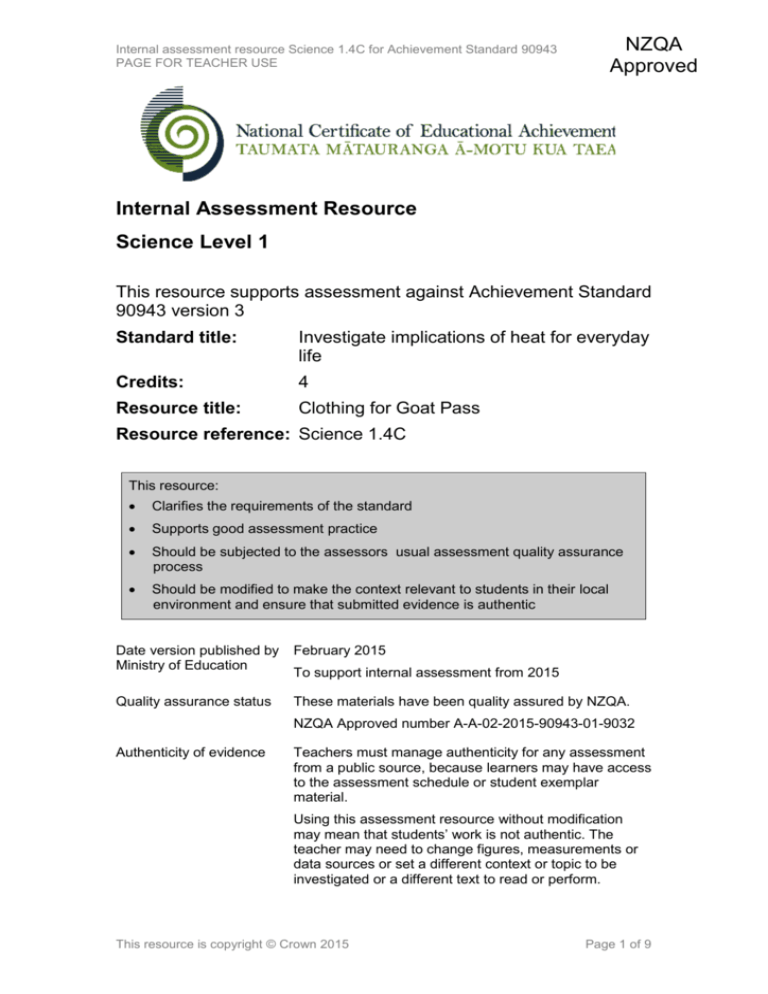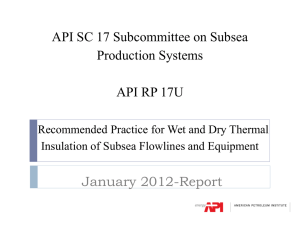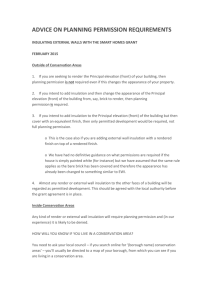Level 1 Science internal assessment resource
advertisement

NZQA Approved Internal assessment resource Science 1.4C for Achievement Standard 90943 PAGE FOR TEACHER USE Internal Assessment Resource Science Level 1 This resource supports assessment against Achievement Standard 90943 version 3 Standard title: Investigate implications of heat for everyday life Credits: 4 Resource title: Clothing for Goat Pass Resource reference: Science 1.4C This resource: Clarifies the requirements of the standard Supports good assessment practice Should be subjected to the assessors usual assessment quality assurance process Should be modified to make the context relevant to students in their local environment and ensure that submitted evidence is authentic Date version published by Ministry of Education February 2015 Quality assurance status These materials have been quality assured by NZQA. To support internal assessment from 2015 NZQA Approved number A-A-02-2015-90943-01-9032 Authenticity of evidence Teachers must manage authenticity for any assessment from a public source, because learners may have access to the assessment schedule or student exemplar material. Using this assessment resource without modification may mean that students’ work is not authentic. The teacher may need to change figures, measurements or data sources or set a different context or topic to be investigated or a different text to read or perform. This resource is copyright © Crown 2015 Page 1 of 9 Internal assessment resource Science 1.4C for Achievement Standard 90943 PAGE FOR TEACHER USE Internal Assessment Resource Achievement standard: 90943 Standard title: Investigate implications of heat for everyday life Credits: 4 Resource title: Clothing for Goat Pass Resource reference: Science 1.4C Teacher guidelines The following guidelines are supplied to enable teachers to carry out valid and consistent assessment using this internal assessment resource. Teachers need to be very familiar with the outcome being assessed by the achievement standard. The achievement criteria and the explanatory notes contain information, definitions, and requirements that are crucial when interpreting the standard and assessing students against it. Context/setting This activity requires students to investigate thoroughly an aspect of heat transfer that has an impact on everyday life. The context for this assessment task is an investigation comparing the effectiveness of different clothing materials to control heat loss of athletes crossing the alpine pass, called Goat Pass, on the Coast to Coast race. Students will perform a practical experiment in groups. They will independently research the insulating effects of materials, process this information, form a conclusion, and present a comprehensive and critical explanation in a report. The explanation in their report should link their prior knowledge, the information gathered on clothing as an insulator, scientific theory of heat, and their experimental data. This assessment is based on heat transfer and requires prior knowledge of conduction, radiation, convection, and temperature as a measure of heat energy. Conditions This assessment activity requires approximately four hours of in-class time, plus outof-class time. Students will work in groups of no more than three to gather the required experimental results. Students will work independently to write their reports. Resource requirements Provide each group with appropriate apparatus to produce a temperature gradient in the range of 0º to 40º Celsius. This could include: beakers, a thermometer and retort stand, and pieces of clothing worn by athletes. This resource is copyright © Crown 2015 Page 2 of 9 Internal assessment resource Science 1.4C for Achievement Standard 90943 PAGE FOR TEACHER USE An example planning template is provided in Teacher Resource A. Use or adapt it, as appropriate, to your students and context. Additional information Information about the Coast to Coast route is supplied: http://goatpassguides.co.nz/default.asp?PageID=24915 This resource is copyright © Crown 2015 Page 3 of 9 Internal assessment resource Science 1.4C for Achievement Standard 90943 PAGE FOR TEACHER USE Teacher Resource A: Planning template Use or adapt this template to suit your context, as appropriate. Investigation question Source Put your question here. You may need to break the question into smaller questions. Use a new page for each additional question. Information Key words In your own words Record information from sources here. Include only what you need. Put reference details here (URLs, texts, articles etc). Take your key words and make new sentences. Use them to help answer your question. List the key words in this column. Use individual words, not sentences. There may be many key words. Summary Summarise your new sentences here. Your summary should answer your question. If your planning template is more than one page, write your summary on the last page. This resource is copyright © Crown 2015 Page 4 of 9 Internal assessment resource Science 1.4C for Achievement Standard 90943 PAGE FOR STUDENT USE Internal Assessment Resource Achievement standard: 90943 Standard title: Investigate implications of heat for everyday life Credits: 4 Resource title: Clothing for Goat Pass Resource reference: Science 1.4C Student instructions Introduction This assessment task requires you to find out and explain how fabrics can protect an athlete from hypothermia. Teacher note: Adapt the time allowance to suit your context. Specify a due date, e.g. “Your due date is…” You will be assessed on how comprehensively you investigate the insulation properties of two materials and implications for everyday life. You will not be assessed on how you gather your data. Task Athletes who compete in the Coast to Coast race need to run over Goat Pass as part of the route covered. Goat Pass is at 1070m above sea level, and is above the bush line. It is exposed directly to major weather systems. There is a major risk of hypothermia and so athletes must choose clothing that allows the skin to breathe but keeps heat in without overheating the athlete. Gather data in experiments you conduct in groups of up to three students. You will independently carry out further investigation. Use the information you collect independently and your experimental results to prepare a report that describes your findings. You have one week of in-class and out-of-class time to complete this work. Refer to Student Resource A for further guidance. Gather primary data. Your teacher will supply you with suitable equipment and material that will enable you to measure the insulation properties of two fabrics worn by athletes across the temperature range of 0º to 40º Celsius. Teacher note: Provide each group with appropriate apparatus to produce a temperature gradient in the range of 0º to 40º Celsius, e.g. beakers, a thermometer and retort stand, and materials such as wool and polypropylene. This resource is copyright © Crown 2015 Page 5 of 9 Internal assessment resource Science 1.4C for Achievement Standard 90943 PAGE FOR STUDENT USE In a group of up to three students, set up and carry out an experiment that tests the ability of the two different materials to prevent heat loss in a typical New Zealand environment. Teacher note: Provide specific guidance or instructions to students about how to carry out the experiment(s). Make sure each member of your group agrees on and records the same data. Gather secondary data Working independently, collect relevant information on insulation from a range of sources. Collect enough information to allow you to discuss the links between heat flow, fabrics, scientific theory, and the results of your experiment. Teacher note: You could provide or adapt the planning template in Teacher Resource A. Prepare and present your report Working independently, write a report that explains the impact of heat loss and insulation on an athlete running the Coast to Coast. Include your data with your report. This resource is copyright © Crown 2015 Page 6 of 9 Internal assessment resource Science 1.4C for Achievement Standard 90943 PAGE FOR STUDENT USE Student Resource A: Further guidance Gathering data Your data should allow you to determine: for the same thickness of material, which is the best insulator Record your data in an organised way. For example, you could draw diagrams showing different configurations of your apparatus, and the corresponding results. Preparing and presenting your report In your report: discuss how the insulation ability of each fabric compares with each other give a scientific description of how the physical properties of materials affect their ability to insulate (prevent heat loss) link the data you have gathered to scientific theory, for example by providing scientific reasons why one material was a more efficient insulator than the other describe how heat is lost by an athlete explain why heat loss should be prevented. Use scientific statements, show calculations, and state units in your report, as appropriate. Show evidence of your own critical thinking. For example, you might elaborate, justify, relate, evaluate, compare and contrast, or analyse the science information you have gathered. This resource is copyright © Crown 2015 Page 7 of 9 Internal assessment resource Science 1.4C for Achievement Standard 90943 PAGE FOR TEACHER USE Assessment schedule: Science 90943 - Clothing for Goat Pass Evidence/Judgements for Achievement Evidence/Judgements for Achievement with Merit The student investigates implications of heat for everyday life. The student investigates, in depth, implications of heat for everyday life. The student investigates, comprehensively, implications of heat for everyday life. The student: The student: The student: gathers and processes data about the relative insulation properties of fabrics used by athletes, and conducts further research into their properties gathers and processes data about the relative insulation properties of materials, and conducts further research into their properties gathers and processes data about the relative insulation properties of materials, and conducts further research into their properties explains how science is involved in insulation used by athletes provides reasons and links these together to clearly explain how science is involved in insulation used by athletes describes how science is involved in insulation used by athletes provides in their report a general description of how heat is lost (heat transfer mechanisms), and may include a diagram or narrative description of experimental results describes link(s) between the physics theory of heat transfer, heat loss in humans , and the two types of fabric. For example (partial), the student describes most of the methods of heat transfer and the effects of insulation: “Heat flows from a hotter region to a colder region.” “Heat transfer in this context will predominantly be via convection...” “Having an insulator between the two regions reduces convection of heat, and radiation and conduction.” How the insulating clothing protects against the effects of cold winds is described. The examples above are indicative samples only. This resource is copyright © Crown 2015 provides in their report an explanation of how heat is lost (heat transfer mechanisms), and may include a diagram or narrative description of their experimental results explains link(s) between the physics theory of heat transfer, heat loss in humans, and the two types of insulation fabric. For example (partial), the student explains most of the methods of heat transfer and the effects of insulation: “Heat flows from a hotter region to a colder region.” Evidence/Judgements for Achievement with Excellence provides in their report a discussion of how heat is lost (heat transfer mechanisms) including the key heat transfer methods, and may include a diagram or narrative description of their experimental results explains key link(s) between the physics theory of heat transfer, heat loss in humans, and the two types of fabric. For example (partial), the student explains most of the key methods of heat transfer and the effects of insulation: “Heat flows from a hotter region to a colder region.” “Heat transfer in this context will predominantly be via convection.” “Heat transfer in this context will predominantly be via convection.” “Having an insulator between the two regions reduces convection, and radiation and conduction.” “Having an insulator between the two regions reduces convection, and radiation and conduction.” How the insulating clothing protects against the effects of cold winds is explained. The student’s report also includes: explanation of the structure of the materials in relation to their ability to be an insulator How the insulating clothing protects against the effects of cold winds is fully explained. The student’s report also includes: description of the structure of the materials in relation to their ability to be an insulator, for example related to the small air pockets available Page 8 of 9 Internal assessment resource Science 1.4C for Achievement Standard 90943 PAGE FOR TEACHER USE explanation of why the structure of the materials reduces heat transfer. The examples above are indicative samples only. for wool explanation of why the structure of the materials reduces convection. Examples of critical evaluation/examination include: experimental apparatus and data scaled up to an estimate of actual performance of an athlete, to allow valid comparisons consideration of the relative amounts of the three types of energy transfer and how significant each type is discussion of limitations of their experiment and effect on their conclusions description of variations between their experimental data and any prior or researched science knowledge, and explanations for why these variations may have happened discussion of how each insulation type is affected by condensation or water absorption, with scientific reasons why and how each type of material might be affected relative abilities of each type of insulation to mitigate the effects of winds or air flow when wet. The examples above are indicative samples only. Final grades will be decided using professional judgement based on a holistic examination of the evidence provided against the criteria in the Achievement Standard. This resource is copyright © Crown 2015 Page 9 of 9







